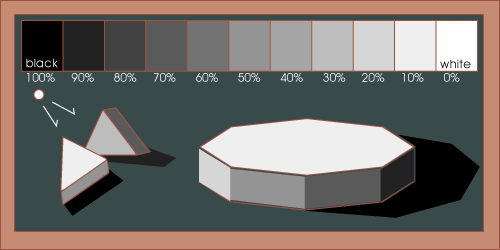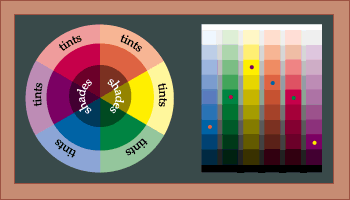This site is made possible by its sponsors.
Please visit them!

Below and in the background: a value scale employing a smoothly nuanced gradation of values.
Below: a value scale — or gray scale — in eight stepped grades of values.
![]()
And another stepped scale produced by hatching and cross-hatching.

Below: another value scale — or gray scale — in which stepped grades of values are labeled for their percentages of black, and values used to give planar shapes greater solidity and depth.

A full range of values can also be produced by a variety of other means. These include hatching and stipple techniques, as well as with textures and patterns of other sorts.
The following illustration diagrams colors of various values. Value changes from pure hues are called shades and tints. On the right, pure hues are marked by dots. Notice how their values — their positions beside the gray scale — are varied.

Changes in value, whether sudden or gradual, can add greatly to the visual impact of art forms. Changes in value can also be used to help the artist express an idea.
One of the senses in which The Oxford English Dictionary (1928, 1972) defines "value" is: "[In] Painting. Due or proper effect or importance; relative tone of colour in each distinct section of a picture; a patch characterized by a particular tone." As a historical dictionary, the OED cites quotations of uses by various English writers as far back as they can be found. The earliest of the OED's three quotes is
"A certain quantity of cold colours is necessary to give value and lustre to the warm colours."
Sir Joshua Reynolds (1723-1792), English painter, lecturer on art, and the first president of the Royal Academy. In a lecture to students at the Royal Academy, Discourses, viii (1778, 1876), 453.
Sir Joshua Reynold's published use of "value" has been read by artworld readers ever since the late 18th century. This suggests that the term has been in use within the English-speaking academia at least since that time.
Art educators generally credit Arthur Wesley Dow (American, 1857-1922) with introducing the teaching of the art elements in the USA through his book Composition, first published in the 1890s, and still in print. Did he use the term "value"? Which of his followers did so?English speakers more typically use this term to refer to emotional or monetary worth. Artworld speakers' exceptional usage from that of the general English speaker can be problematic.
![]()
Is there a better word for this than "value"?Outside of the art world, "value" is primarily understood to mean "worth." Why does the art world persist in speaking of "value," when the maintenance of this convention chonically demands explanation? Even with explanations, using the word "value" frequently result in misunderstanding! Is there any way to avoid these undesirable results? Yes! Scientists refer to the same lightness-darkness phenomena, and never create the confusion with which we cope. They simply use the terms "luminance" and "luminosity" — interchangeable synonyms. Both are typically defined as "the condition or quality of emitting or reflecting light." "Luminance" and "luminosity" concern what is either self-generated or reflected light. Understanding that art speakers more typically employ "value" to reference the continuum of lightness / darkness of reflected light, when we speak of the "luminosity" of any passage in a drawing, painting or print, we are unbothered about whether the reader might think the surface is lit internally or from its back. We also posit that surfaces are generally "well lighted." Typically we are talking about the degree of a color's potential to reflect that light. Whenever we are discussing a work which emits its own light (backlighting, projection, incandescence, fluorescence, halogen, neon, laser, light-emitting diode, etc.), we are likely to observe and point out that fact, and consider other aspects of the work with this one in mind. In other words, in contrast to uses of the word "value," the potential for the L-word's causing confusion is comparatively negligible. Indeed, a scientist (or photographer) measuring the potential of a surface to reflect light would speak of its luminance, unworried that the surface is not itself generating the light. instead, a scientist, would measure the surface's luminance in relation to the brightness (measured in lumens or candle-power) of the light cast upon it. Every new word requires explanation, but "luminance" and "luminosity" have the advantage of coming from the Latin root lumen — light. This old word gave birth to the words luminous, luminary (a person who has achieved eminence in his / her field), illuminate, and illumination. As a rule, ArtPage is descriptive of the meaning of words, and rarely prescriptive of what words should mean. I feel that ArtPage should point out some of the problems some words can get us into. This note presents an instance of such a tangle. The clarity lost by the art world's clinging to its use of the word "value" instead of "luminance" is plainly problematic. The great advantage to shifting this paradigm is that whereas most English speakers understand "value" to mean worth, "luminance" has no other meanings at variance to the one we have intended to communicate when we have used the word "value." - MRD Let me know what your experince has been, and how you think about these issues! |
Also see chiaroscuro,
deep, feather,
gradation, gray
scale, inpaint, positive,
shadow, and value
scale.
https://inform.quest/_art